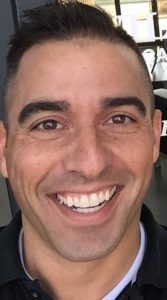After gaining an interest and excitement in Spanish and English through inspirational teachers during his early school years, Corey Cramb studied abroad in Mexico.
The experience affirmed his passion: he wanted to teach foreign language.
“I knew I wanted to be involved in education, just through my own experiences as a student,” he said. “I had a really positive experience with my own teachers in high school; I had really dynamic teachers that were just fun to be around and made learning English and foreign language such a joy — I wanted to give that back to other students.”

Corey Cramb has been an instructor with IMSE since 2013, with specialized knowledge in ELL students.
Cramb decided to go to college with the goal of becoming a teacher, and graduated from Eastern Michigan University with a degree in Secondary Education with a concentration in Foreign Language Instruction.
Though he expected to quickly get to work as a Spanish teacher, his path in language instruction instead took a surprise twist.
“I went to school to teach Spanish, but what I ended up doing was teaching English to Spanish-speakers,” Cramb said with a laugh.
Cramb first worked with Farmington Public Schools in his home state of Michigan, filling in as a long-term sub while a full-time teacher was away. When that stint ended, Cramb said he jumped at the chance to take on a new position as a Spanish teacher in Wayne County.
For the first few years, Cramb said he was the traditional Spanish teacher he’d dreamed of becoming. As more Spanish-speaking families with little to no understanding of the English language began to move into the school district, Cramb said the need for teachers who could speak more than one language became more important than ever.
After helping a fellow teacher translate a hand-out being sent home to students, Cramb said he began to get requests for Spanish-English communications regularly from a range of staff.
“There was definitely a need for English language learning instruction, and no one knew really what to do,” he said. “It was kind of like putting a band-aid on a larger problem.”
About mid-way through his 12-year career at the school, Cramb said his duties transitioned into serving Spanish-speaking students who needed aid in English — swapping Spanish instruction for ELL.
“[Prior to that] there wasn’t a lot of conversation going on about [ELL],” he said. “But you could see the writing on the wall. This population wasn’t going anywhere, if anything it’s going to increase tremendously — so for me it signaled a need that we hadn’t recognized yet that was going to significant.”
Then, in 2013, Cramb met IMSE Co-founder Jeanne Jeup. Knowing of his dedication to education and his unique, bilingual background, Jeup invited Cramb to attend an IMSE training.
Instantly, Cramb said he knew it was the missing component he’d been waiting for as an educator — particularly because teaching literacy was never part of his teacher preparation experience during university.
“It was a wonderful piece that was missing,” he said. “Because I didn’t go to college to learn how to teach kids to read, that wasn’t the purpose of my education. So when my job became more about helping students that speak Spanish learn more about using English in reading and writing, I didn’t really know how to teach them to read, until IMSE’s Orton-Gillingham and phonics approach.”
“It’s not part of your preparation program at university, and it seems like it should be,” Cramb said.
It wasn’t until he primarily began teaching English did he truly realize the literacy challenges both students — and teachers — were facing.
“You’d think that you would learn these things, but you don’t. And then when you’re in the classroom, there’s so many things that come at you. You learn in college what education should look like, and then it’s different when it’s actually [in the classroom]. I didn’t feel I had the tools I needed, but then IMSE’s approach was so easy to implement — I could have gone back to school the next day and done it. So many times trainings are applicable in theory, but not in practice, so that’s the huge difference that I saw.”
After witnessing the power of IMSE’s Orton-Gillingham training, Cramb said he knew that’s what he wanted to do with his future.
In 2013, he left his job as a Spanish teacher and began a new chapter with IMSE, helping reach educators and students in capacities beyond what he could have done in his single classroom, he said.
“This is what draws me in: I have a great time where I work. IMSE, since the beginning, has been such a transformational company,” Cramb said. “The powerful thing about this job is that I didn’t know if I was ready to leave the classroom, until now — because the amount of students I’m reaching now is exponentially more from helping all the teachers that I’ve helped.”
Not just that, but Cramb said he’s formed long-term connections with the educators he’s served through IMSE, keeping in touch, checking-in and remaining a source of support for teachers.
“Seeing them in action with real students, starting off shaky and then 50 lessons later being an Orton-Gillingham all-star, that’s really cool,” he said. “There’s really neat things that we [as trainers] get to see a lot.”
When he’s not teaching educators how to teach reading, Cramb said he’s an “outdoors enthusiast” and triathlete who enjoys running and cycling. In October, he will run in the Detroit Marathon.
Though traveling across the nation for IMSE trainings can get exhaustive, Cramb said it’s never difficult to find the motivation to keep going.
“I don’t know what else I would do that’s as flexible, and as rewarding. I want to do it as long as I have the stamina for it,” he said. “I feel like I keep getting better and IMSE keeps getting better, so why mess up a good thing?”
